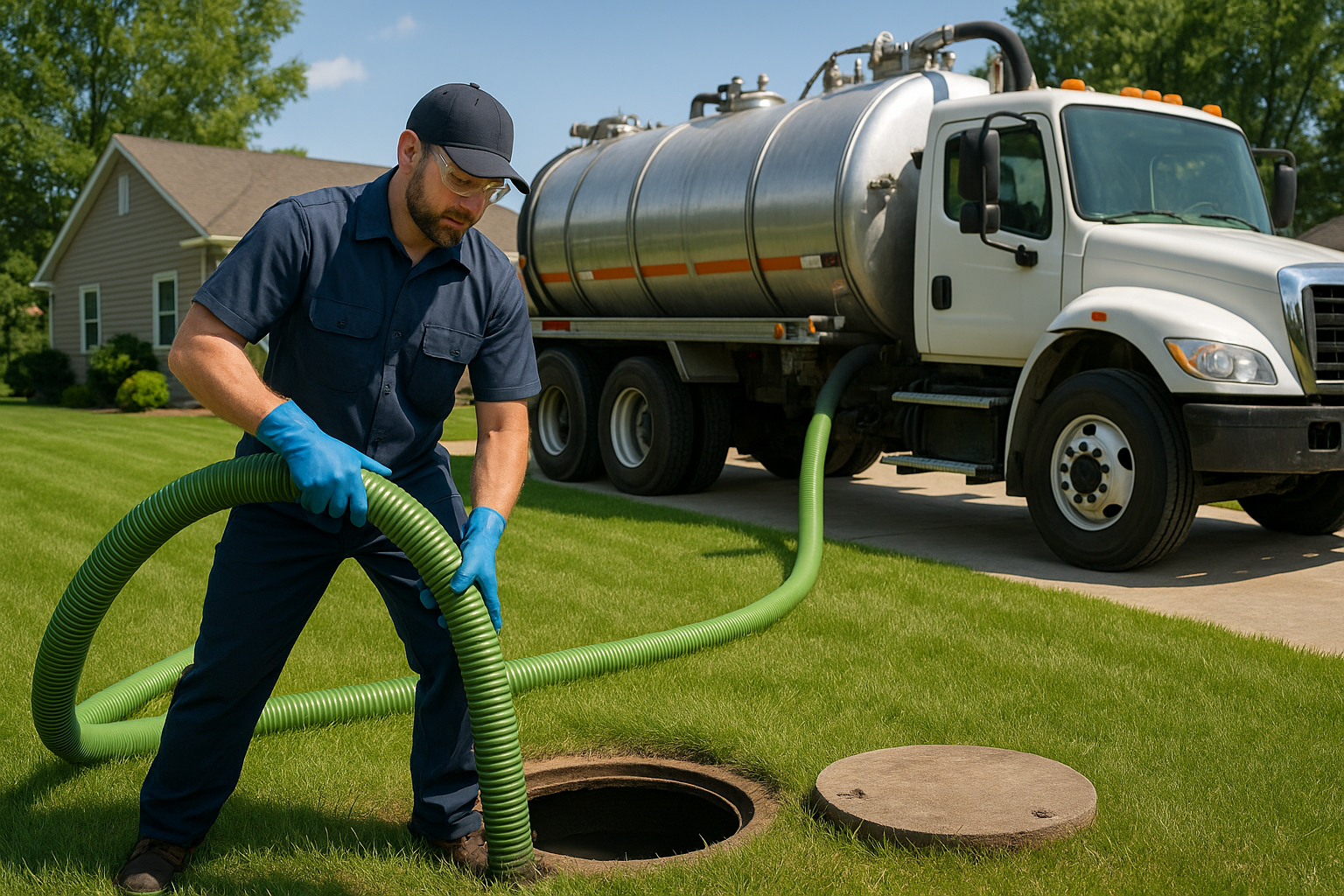Have you ever wondered if your septic tank is overdue for a pump out? Sticking to a proper septic tank maintenance schedule can save you from costly headaches later. It’s easy to overlook, but once issues like odors or backups appear, it’s already too late. Many homeowners only think about their septic system when problems arise, but consistent care prevents emergencies and protects your home’s value.
Understanding how to know when to pump your septic tank and maintaining the right septic tank cleaning frequency can extend your system’s lifespan, reduce repairs, and safeguard your property. A neglected system can cause contamination, lawn damage, or groundwater pollution—issues that are much more expensive to fix.
By following practical care tips and learning when to empty your septic tank, you can keep everything running efficiently. Knowing the signs your septic tank is full—such as slow drains, sewage odors, or pooling water—helps you act before damage occurs.
This guide shares expert advice on how to maintain your septic system and determine the right pumping schedule for your household. You’ll also discover how professional services, regular inspections, and consistent upkeep contribute to a healthy system that lasts for decades.
Understanding the Role of Septic Tank Pumping
Your septic system works quietly behind the scenes, but understanding how it operates is key to keeping it in top shape. During a septic tank pump out, professionals remove waste solids and scum buildup to keep wastewater flowing freely into the drainfield. Without this step, sludge accumulation can lead to backups and costly damage.
Ignoring this maintenance can lead to system blockages or failures. Many homeowners underestimate the cost of septic repairs until faced with major problems. Prevent this by following a recommended pumping schedule and scheduling periodic inspections.
Routine service also helps track tank levels, monitor the average lifespan of your septic system, and ensure all components function properly. Understanding these elements helps reduce replacement costs and unexpected breakdowns.
When learning how to maintain a septic tank, focus on prevention instead of reaction. Advancements in septic system maintenance make it easier than ever to stay proactive. With consistent care, your system can work efficiently and avoid premature replacements—saving you both stress and money.
What Really Determines How Often You Need a Pump Out
The frequency of septic maintenance depends on multiple factors—such as tank capacity, household size, and water usage habits. A household septic tank size guide helps estimate your pumping needs accurately.
Experts typically recommend pumping every 3–5 years, but each home is different. Smaller households may go longer between pump outs, while larger families might need service more often. Key factors include:
- Tank Size: Larger tanks fill slower and need less frequent pumping.
- Water Usage Habits: Frequent laundry, dishwashing, or long showers increase buildup.
- System Design: Older systems or smaller tanks may require more frequent attention.
- Type of Waste: Using safe household products for septic systems keeps bacteria balanced.
Knowing how to avoid septic backups and practicing DIY maintenance ensures your system stays healthy. A well-planned septic tank pumping recommendation helps you stay ahead of problems, preventing backups or costly failures down the line.
Why Regular Septic Tank Pumping Pays Off
Preventive care costs far less than repairs. Regular septic tank cleaning keeps your system efficient and prevents severe issues. Whether you prefer DIY maintenance or professional cleaning, consistency is key.
Routine service helps avoid backups, extend your system’s lifespan, and eliminate unpleasant odors. Waiting too long may result in overflow, clogged pipes, or system failure.
Here’s why regular maintenance is worth it:
- Prevents Costly Repairs: Regular pump outs avoid overflow and drainfield damage.
- Keeps Your Home Comfortable: Reduces unpleasant smells and backups.
- Extends System Life: Improves how long your septic tank lasts.
- Protects the Environment: Prevents soil and groundwater contamination.
- Saves Money: Costs less than emergency cleanups.
By scheduling a septic tank pump out, you ensure proper operation and peace of mind. It’s a small investment that protects your home, property, and the environment.
The Challenges of Septic Tank Pumping You Should Know
While necessary, septic pumping comes with its challenges. Some homeowners hesitate due to the cost differences between pumping and cleaning, or they simply forget their next service date. Others don’t realize what happens if they skip it—leading to blockages, odors, or full system failure.
Common challenges include:
- Service Costs: While pumping has a cost, it’s minimal compared to replacements.
- Scheduling Hassles: Booking with professionals can take planning.
- Disruptions: Accessing tanks may briefly affect your yard.
- Lack of Awareness: Many wait until failure signs appear.
To overcome these issues, plan ahead. Look for reputable septic service providers and compare reviews. Some even offer reminder programs for future appointments.
Budgeting yearly for maintenance and staying proactive keeps your septic care routine stress-free. It’s all about turning a necessary task into a manageable habit that keeps your property safe and efficient.
How to Stay on Top of Your Septic Tank Pumping Schedule
Staying organized with your septic tank maintenance schedule ensures long-term system health. Start by reviewing your last pump date and set reminders so you don’t miss future maintenance. Understanding your household’s habits also helps you create a personalized plan.
If you’re unsure about your system’s setup or need to locate your tank, professionals can help identify it and advise on inspection timing. Combine inspections with cleaning for best results.
Here’s a simple checklist:
- Check Records: Know when your last pump-out was done.
- Evaluate Household Use: More occupants mean more frequent service.
- Set Reminders: Use phone apps or calendars.
- Schedule Ahead: Don’t wait until signs of trouble appear.
- Pair Services: Combine inspection and cleaning for convenience.
Pumping before issues start reduces your septic tank inspection cost and keeps your system efficient. Staying consistent saves money, prevents stress, and keeps your home’s wastewater system performing at its best.
The Future of Septic System Care
Modern innovations are transforming septic maintenance. Smart tools, sensors, and eco-friendly products now help homeowners monitor septic tank sludge buildup in real time and receive alerts before problems occur.
Emerging trends include:
- Smart Monitoring Systems: Notify you when the tank needs service.
- Eco-Friendly Additives: Improve sustainability and reduce waste.
- Subscription-Based Care: Automated reminders for inspections and cleanings.
- Updated Regulations: Septic system compliance rules for better groundwater protection.
For rural properties, rural septic maintenance tips are especially important to ensure efficiency and protect nearby wells. The future of septic care lies in prevention, automation, and environmental awareness.
Embracing these innovations means fewer emergencies, lower costs, and a system that stays reliable for years to come.
Keeping Your Septic System Healthy for the Long Run
Long-term septic care comes down to consistency and awareness. You’ve learned how often to clean your system, recognize septic system failure signs, and manage your maintenance schedule effectively.
Keep these tips in mind:
- Follow your recommended pumping interval to prevent overflows.
- Watch for early signs your septic tank is full.
- Use only safe cleaning products for septic systems.
- Have professionals ready for emergencies when needed.
By staying proactive, you’ll extend your system’s life, reduce repair costs, and protect your property value. Regular care ensures your septic setup remains efficient, safe, and environmentally friendly for decades.






